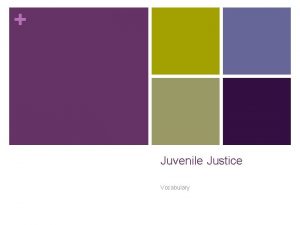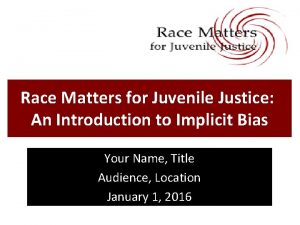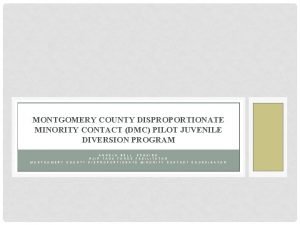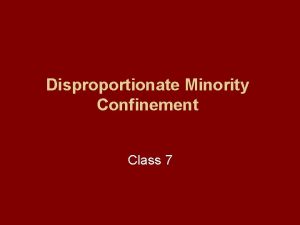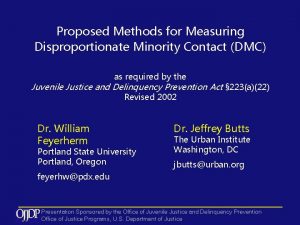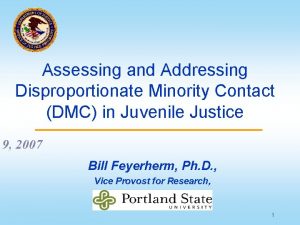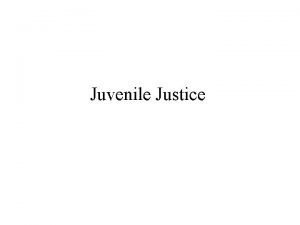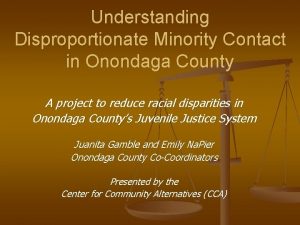DISPROPORTIONATE MINORITY CONTACT DMC IN THE JUVENILE JUSTICE










- Slides: 10

DISPROPORTIONATE MINORITY CONTACT (DMC) IN THE JUVENILE JUSTICE SYSTEM THIS TOPIC SURROUNDS THE ISSUE OF THE OVERREPRESENTATION OF MINORITY JUVENILES IN THE SYSTEM.

BRIEF INTRODUCTION AND THESIS This is significant to the study of Juvenile Justice because it attempts to address the reasons why there is a great gap between the reported detained and confined minority youth and their white counterparts. More importantly, this area of research emphasizes the elemental theme of justice and fair-play. Differences in processing, portrayal in the media and the fact that laws are skewed in a way that disfavors less affluent juveniles are some of the factors that denote an overrepresentation of minority youth in the juvenile system.

DEFINITION OF DMC occurs when the proportion of minority youth who go through the juvenile justice system surpass the proportion of minority youth in the general population. Disproportionality becomes progressively worse as minority juveniles continue through the system, as decisions that occur early in the process (i. e. , arrest and referral) will increase overrepresentation.

DIFFERENCES IN PROCESSING If the system processes minority and white offenders differently, it could be because of contemporary bias, either overt or implied, or because of historically rooted patterns of racial inequality. It could be that crime policies are at the root of racial discrimination. � For example, the system may enforce and punish offenses common in minority communities more harshly than those common in white communities. The disparities could also be due to discretion in criminal justice decision making.

CONSEQUENCES DOWN THE ROAD DMC with the justice system has consequences that extend far beyond involvement in the system itself Researchers must examine empirically these potentially far-reaching consequences: � the extent that involvement in the justice system affects education labor force participation voting family formation


PORTRAYAL IN THE MEDIA Media coverage (especially local news) disproportionately connect crime with race and ethnicity. Studies have shown that African Americans and Hispanics were over represented as perpetrators in news reports, especially those involving violent crimes, and underrepresented as victims. Disproportionate linking of crime with people of color, and overrepresentation of young people (especially minority youth) in stories of criminal violence may have a significant effect on public attitudes toward crime, race, and youth. According to the 2006 Network Brownout Report conducted by the National Association of Hispanic Journalists, crime made up a large portion of the time devoted to portraying Latinos. Researchers found that crime stories made up about 18 percent of Latino news stories, and most of the time, “Latinos were the perpetrators, not the victims. ”

SUBJECTIVITY IN THE SYSTEM The law is skewed with respect to the social factors that are considered, in terms of making a determination of who gets locked up and who doesn't. And since it is skewed in such a way as to essentially favor more affluent kids or to punish kids that are less affluent, that has racial and ethnic consequences. Prejudice in prosecution, defense, and the courts, and most importantly law enforcement contact with minority juveniles, is another reason that there is racial imbalance in the system. “Stereotypes are so embedded in the psyche of human beings, that those stereotypes come to play. Assumptions get made. ”

CONCLUSION The disparity between minority and non-minority juveniles exists both in self-reports of offending and in official records of contacts with the criminal justice system, including encounters with police, arrests, and convictions More broadly, the gap could be attributable to the role either of race itself or of other factors that may be consequential to race, such as socioeconomic status, family structure, neighborhood dwelling, or any combination of the three. Stereotypes and assumptions are relevant in terms of police and court discretion. Minorities are overrepresented as perpetrators, unrepresented as victims.

SOURCES Piquero, Alex R. "Disproportionate Minority Contact. " The Future Of Children 18. 2 (2008): 59 -79. JSTOR Arts & Sciences IV. Web. 24 Sept. 2012. Soler, Mark, and Lisa M. Garry. "Reducing Disproportionate Minority Contact: Preparation at the Local Level. " National Criminal Justice Reference Service. Office of Juvenile Justice and Delinquency Prevention, n. d. Web. 20 Sept. 2012. <https: //www. ncjrs. gov/pdffiles 1/ojjdp/218861. p df>. "From Both Sides of The Bench: Is the System Race Biased. " Interview. PBS, n. d. Web. 24 Sept. 2012. <http: //www. pbs. org/wgbh/pages/frontline/show s/juvenile/bench/race. html>. Sharp, Gwen. "Sociological Images. " NYPDs Stop-and-Frisk Policy » . N. p. , n. d. Web. 15 Oct. 2012. <http: //thesocietypages. org/socimages/201 2/10/15/nypds-stop-and-friskpolicy/comment-page-1/>. Williams, Marsha E. , and John C. Condry. "Living Color: Minority Portrayals And Cross -Racial Interactions On Television. " (1989): ERIC. Web. 15 Oct. 2012. Michael D. Slater, et al. "Race And Ethnic Representations Of Lawbreakers And Victims In Crime News: A National Study Of Television Coverage. " Social Problems 57. 2 (2010): 269 -293. Academic Search Complete. Web. 15 Oct. 2012.
 Dmc debt management contact number
Dmc debt management contact number Undisciplined juvenile petition nc
Undisciplined juvenile petition nc Criminal law and juvenile justice unit 2
Criminal law and juvenile justice unit 2 Juvenile justice alternative education program
Juvenile justice alternative education program Juvenile justice system in georgia
Juvenile justice system in georgia Ra 9344 juvenile justice and welfare act
Ra 9344 juvenile justice and welfare act Georgia juvenile justice system
Georgia juvenile justice system Coalition for juvenile justice
Coalition for juvenile justice Juvenile justice vocabulary
Juvenile justice vocabulary Juvenile justice act 2000
Juvenile justice act 2000 Race matters for juvenile justice
Race matters for juvenile justice








